|
The
United Reformed Church
FORMERLY
THE CONGREGATIONAL CHURCH
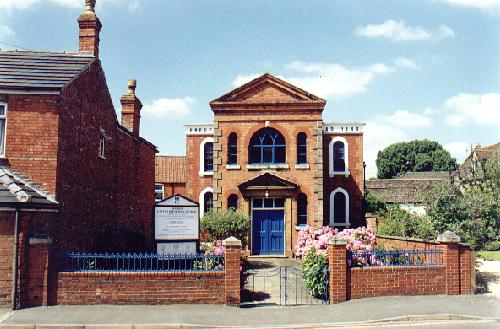
One of the busiest religious buildings in Bourne is the United Reformed Church
that is used for a variety of community activities as well as services. The first signs of congregationalism appeared in the town during the mid 19th century and the
Congregational Chapel [now the United Reformed Church] opened in Eastgate in 1846, constructed from the distinctive red brick that was used for many buildings in the town during that period.
There was a rapid growth in the size of the congregation that reached 400 within three years. A Sunday school was started in 1849 and for a long time its meetings were held in private houses
yet by 1874 there were 235 children on the roll with 18 voluntary
teachers. The popularity was such that a permanent Sunday school building was erected
towards the end of the century on land adjoining the church at a cost of
£1,000, the architect being Mr F G Shilcock of Bourne and the contractor
Mr Thomas Hinson, also of Bourne. The new building consisted of a
large central hall, 60 feet by 33 feet, with 12 flanking classrooms
opening into it.
The memorial stone laying was held on Thursday 10th
August 1899 when the need for the new premises was stressed by the pastor,
the Rev T H Parker. "For many years", he said, "the
enlargement of the school has been a matter of deep concern to officers
and teachers as 300 scholars have to be accommodated in a space designed
for a third of that number. For the past 15 years, the work of collecting
contributions has been perseveringly continued and now over £400 of the
amount required has been secured." Memorial stones were laid by
Alderman William Wherry, Messrs Thomas Mays, George Mays, Edward Andrew
and John Wall, and afterwards, over 200 people sat down to a public tea in a large tent on the
Abbey Lawn. In the evening, a public meeting
was held when addresses were given by several visiting
ministers. Collections during the day in aid of the project amounted to
£106 including several handsome donations.
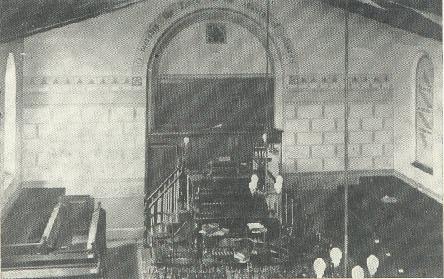
This is the
interior of the church as it was prior to the major alterations
that
were completed during 1911.
The
building was officially opened on Wednesday 17th January 1900 when the
pastor, the Rev T H Parker, presided at the ceremony and Alderman George
White of Norwich [later Sir George White], an eminent old scholar and
teacher at the Sunday School, gave a dedication address. The leading
non-conformists of the town and district attended including the Rev A
Eason (Sleaford), the Rev C R Gardner (Stamford), the Rev James Carvath
(Bourne Baptists) and the Rev H Brown (Bourne Wesleyans) and Alderman
William Wherry. The meeting was told that £500 had already been raised
towards the cost of the building and the opening ceremony brought in
another £150 in donations.
Soon afterwards, in 1911, the church was altered and renovated and the re-opening ceremony was performed with a silver key by
Sir George White, who had become M P for North West Norfolk, and was a former president of the Free Church Council.
|
A
NEW LOOK FOR THE CHAPEL INTERIOR
The extensive alterations to the chapel in 1911 included new
seating arrangements, the presentation of a communion table and
chair and two stained glass memorial windows, extensions to the
gallery and the installation of the present pulpit and organ that
remain in use today although an electric blower was installed in
1934 and replaced in 1991.
The organist and choirmaster at that time, Mr T W Bradley, who was
appointed in 1936 to succeed Mr Ashby Swift, is pictured in 1946
seated at his usual place before the console (right). He died in
1989. |
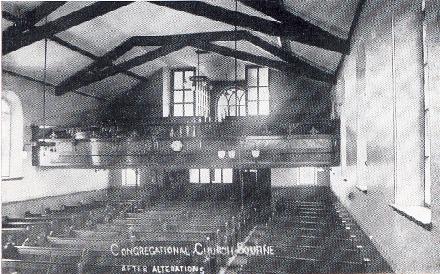 |
|
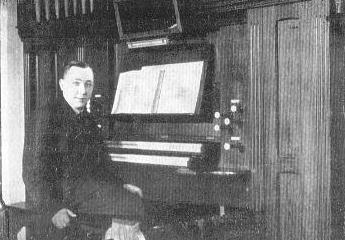 |
Old
minute books containing records of meetings give an insight into the
growth and activities of the church and it is obvious that membership was
regarded far more seriously in earlier times. In 1868, a member was
expelled for creating a disturbance in a polling booth and a little later,
a resolution was passed saying that any member who missed three
consecutive sacrament services without good reason should be interviewed
and given one more chance. If they still failed to attend, then their name
would "regretfully be struck from the Church Roll".
When
the church celebrated its centenary in 1946, the secretary Mr W H Hemsell,
said:
We
speak, and probably think too much of the church as a building but the
real church consists of its members, and the record of its achievements
which really matter are contained in the church roll of members. We are
proud that today, the number of members is the highest ever recorded since
those faithful six founders banded together in 1846. Today, we have 130
names on the roll and the number of those who have been welcomed into the
fellowship of this church since the first communion service on 20th
October 1846 is no fewer than 491. Through varied experiences of spiritual
death and prosperity, the church and Sunday School have unfailingly
borne their witness for a century and the faithfulness and sacrifice of
those who have gone before should encourage us to a deeper devotion with
renewed hope and courage to face the tasks that still await us.
|
IN THE
BEGINNING
The following six people
formed themselves into a church of the order called Independents
on 20th October 1846:
John Presgrave, Elizabeth
Presgrave, Eleanor Presgrave, Robert Howe, Mary Howe and William
Ward.
The Rev J Islip of the Star
Lane Church at Stamford administered the sacrament of the Lord's
Supper and Mr F Pinney of Stamford, "who ministers to us in
the Word and Doctrine, communed with us". At the first church
meeting held on 19th November 1846, it was resolved that: "Mr
Pinney be requested to continue on the same terms as formerly
agreed upon." At the same meeting, Mr Todd was elected leader
of the singing and Mr John Presgrave was elected deacon and
secretary (then called clerk).
Mr Pinney carried on the work
of the Pastorate, assisted by various ministers from Peterborough,
while the Rev J Islip exercised oversight over the church. In
1849, Mr Anderson from Castle Bytham joined Mr Pinney as
co-pastor, each receiving a remuneration for their services the
sum of £18 per annum. In 1850, Mr Anderson became sole pastor,
receiving a stipend of £40 a year. The following were pastors of the
church during the first 100 years of its existence from 1846 until
the centenary celebrations in 1946: |
|
1852-53
Rev J S Knight
1853-54
Rev W Roberston
1854-56
Rev R Lumsden
1857-68
Rev D Horsecraft
1869-73 Rev S Chisholm |
1874-80
Rev Mark Lucas
1880-83
Rev J Hamilton
1883-90
Rev Eason
1890-1908
Rev T H Parker
1908-1919
Rev J C Jones |
1920-25
Rev J A Halfpenny
1926-31
Rev P V Wickenden
1933-37
Rev D Brown
1937-43
Rev H C Spencer
1943-
Rev W J Rees |
|
THE CHURCH
TODAY |
|
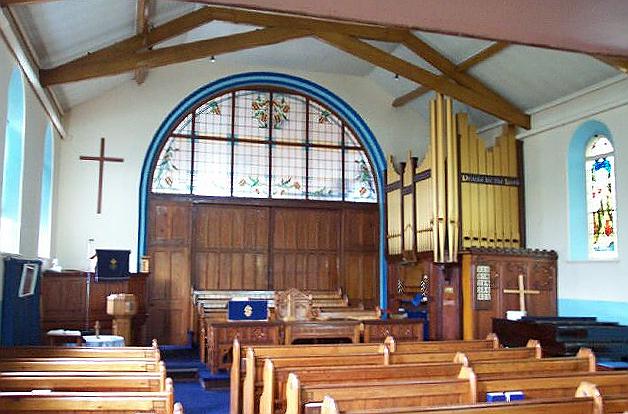 |
|
The
interior of the United Reformed Church (above) and the Sunday School
hall (below), both photographed in July 2003.
|
|
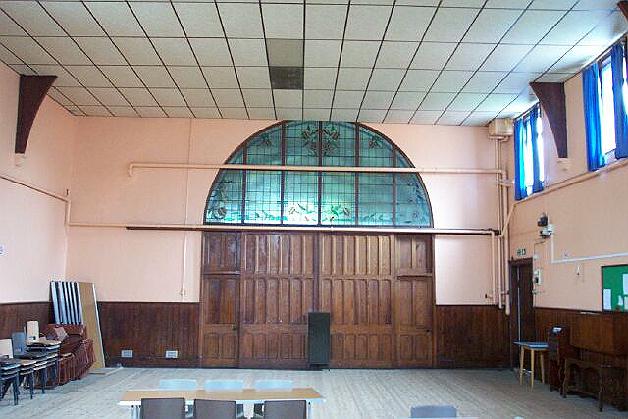 |
|
A BIRTHDAY CELEBRATION
The 12th anniversary of the Independent chapel,
Eastgate, was celebrated on the 1st inst. and two following days. On
Sunday, three sermons were preached by the Revs B O Bendall, of
Stamford, and the Rev Edward Hassan, of the New College, London. On
Monday afternoon, the annual tea meeting took place in the new
school-room when about 200 friends sat down to the festive board.
After tea, addresses were delivered by the Rev J B Pike, the Rev D
Horscraft and Mr Bishop. Amongst other things, the speakers
congratulated the friends upon the fact of their having since the
last anniversary produced a new school-room, adjoining the chapel,
which had proved a great improvement in many respects, affording
increased facilities for instructing the children of this
neighbourhood. Mr Horscraft, in the course of his address, said it
was a source of satisfaction, and gave great cause of thankfulness
to God that they had obtained a new and commodious school-room and
that by the liberality of the friends and the kind assistance of all
denominations in the town it was already two-thirds paid for: the
debt on the chapel being now entirely liquidated. At 7 o'clock on
Monday evening a sermon was preached by the Rev J C Jones, M A, of
Spalding. On the following afternoon the Sabbath school children
connected with this place of worship had their tea treat in the new
school-room - several friends had also a social tea in the same
room, and afterwards accompanied the children to a field where they
were allowed to recreate in juvenile sports the remainder of the
evening. The different services and meetings were remarkably well
attended and the amount of collections, &c., testified the
satisfaction of those who patronised the cause.
- news report from the Stamford Mercury, Friday 6th August 1858. |
|
THE REV THOMAS HUGHES PARKER
The building of the Sunday School in 1900 was
largely motivated by the minister at the time, the Rev Thomas
Parker, who inspired the fund raising and supervised the planning.
He was born at Bishop Auckland in County Durham in 1864 but the
family moved to Hartlepool where he was educated and after leaving
school he became apprenticed to a printer, mainly to earn sufficient
money to fulfil his ambition to become a minister. He eventually
attended Paton College in Nottingham where he qualified and after
marrying Emma Hester Curry in 1891, accepted the appointment as
pastor of the Congregational Church at Bourne in 1895. His wife died
three weeks after the birth of their only child in 1900 and is
buried in the town cemetery. He later married Ethel Branston, one of
his congregation and a member of a prominent Bourne family, and in
1908 they moved to Horwich, Lancashire, where he became minister at
the New Chapel. He remained there for 15 years, retiring in 1923 to
West Bridgford, Nottinghamshire, where he died on 20th August 1946,
aged 82. Ethel survived him by 13 years and died on 10th February
1959, aged 83 and they are buried side by side in a double grave at
the town cemetery in South Road. In later years, their only daughter
Emma wrote of her years growing up in the town.
See Memories of a Bourne
childhood |
See also
The story of the
church from the minutes
Sir George White
John Arnold
William Hemsell Frederick
Sones
Sunday Schools
Church feasts and treats
Sunday School treat of 1912

Go to:
Main Index Villages
Index
|





